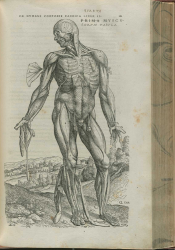De humani corporis fabrica, Andreas Vesalius
Latin for “On the fabric of the human body,” De humani corporis fabrica is a set of seven books on human anatomy published by Andreas Vesalius. Each book in the collection is separated in to specific body systems, such as “Bones and Cartilages” and “Ligaments and Muscles,” and are meant as a guide to Vesalius’ lecture series. Working in tandem with various Renaissance artists from the “studio of Titian,” Vesalius’ collection is considered the first major work of modern anatomy, replacing the old Galen dominated school of thought. The drawings are exceptionally detailed, and focus on the procedural steps in dissection. Due to the widespread use of the printing press, a condense version of De humani corporis fabrica was released to the general public and gained widespread popularity.
Source:
Bambach, Carmen. “Anatomy in the Renaissance”. Heilbrunn Timeline of Art History. Metropolitan Museum of Art, Oct., 2002. Web. 15 Feb., 2018. Link
Wikipedia. "De humani corporis fabrica." Wikipedia, 15 Feb. 2018. Web. 15 Feb. 2018. Link
Image Source:
Image courtesy of Historical Anatomies of the Web page 181, retrieved online.

